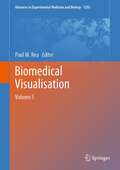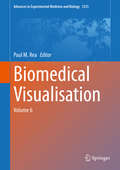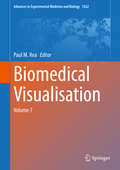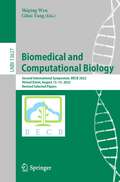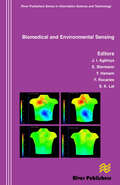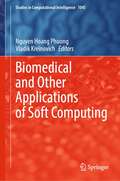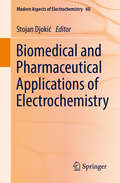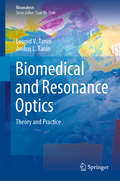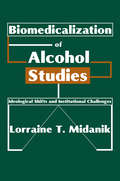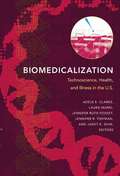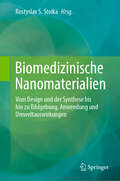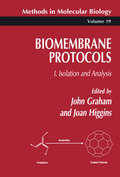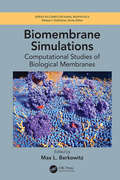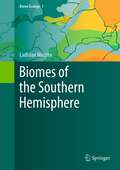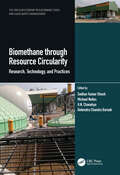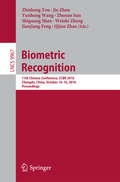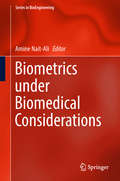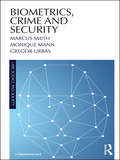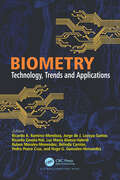- Table View
- List View
Biomedical Visualisation: Volume 5 (Advances in Experimental Medicine and Biology #1205)
by Paul M. ReaThis edited volume explores the use of technology to enable us to visualise the life sciences in a more meaningful and engaging way. It will enable those interested in visualisation techniques to gain a better understanding of the applications that can be used in visualisation, imaging and analysis, education, engagement and training. The reader will be able to explore the utilisation of technologies from a number of fields to enable an engaging and meaningful visual representation of the biomedical sciences, with a focus in this volume related to anatomy, and clinically applied scenarios. The first four chapters highlight the diverse uses of CT and MRI scanning. These chapters demonstrate the uses of modern scanning techniques currently in use both clinically and in research and include vascular modelling, uses of the stereoscopic model, MRI in neurovascular and neurodegenerative diseases, and how they can also be used in a forensic setting in identification. The remaining six chapters truly demonstrate the diversity technology has in education, training and patient engagement. Multimodal technologies are discussed and include art and history collections, photogrammetry and games engines, augmented reality and review of the current literature for patient rehabilitation and education of the health professions. These chapters really do provide “something for everyone” whether you are a student, faculty member, or part of our curious global population interested in technology and healthcare.
Biomedical Visualisation: Volume 6 (Advances in Experimental Medicine and Biology #1235)
by Paul M. ReaThis edited book explores the use of technology to enable us to visualise the life sciences in a more meaningful and engaging way. It will enable those interested in visualisation techniques to gain a better understanding of the applications that can be used in visualisation, imaging and analysis, education, engagement and training. The reader will be able to explore the utilisation of technologies from a number of fields to enable an engaging and meaningful visual representation of the biomedical sciences, with a focus in this volume related to anatomy, and clinically applied scenarios. The first eight chapters examine a variety of tools, techniques, methodologies and technologies which can be utilised to visualise and understand biological and medical data. This includes web-based 3D visualisation, ultrasound, virtual and augmented reality as well as functional connectivity magnetic resonance imaging, storyboarding and a variety of stereoscopic and 2D-3D transitions in learning. The final two chapters examine the pedagogy behind digital techniques and tools from social media to online distance learning techniques.
Biomedical Visualisation: Volume 7 (Advances in Experimental Medicine and Biology #1262)
by Paul M. ReaThis edited book explores the use of technology to enable us to visualise the life sciences in a more meaningful and engaging way. It will enable those interested in visualisation techniques to gain a better understanding of the applications that can be used in visualisation, imaging and analysis, education, engagement and training. The reader will be able to explore the utilisation of technologies from a number of fields to enable an engaging and meaningful visual representation of the biomedical sciences, with a focus in this volume related to anatomy, and clinically applied scenarios. All chapters in this volume feature collaborative and innovative postgraduate research projects from graduate students of the MSc Medical Visualisation and Human Anatomy. This pioneering, world-leading postgraduate taught degree program is a joint partnership degree between the School of Life Sciences within the College of Medical, Veterinary and Life Sciences in the University of Glasgow, and the School of Simulation and Visualisation, The Glasgow School of Art. These chapters truly showcase the amazing and diverse technological applications that have been carried out as part of their research projects.
Biomedical Visualisation: Volume 8 (Advances in Experimental Medicine and Biology #1260)
by Paul M. ReaThis edited book explores the use of technology to enable us to visualise the life sciences in a more meaningful and engaging way. It will enable those interested in visualisation techniques to gain a better understanding of the applications that can be used in visualisation, imaging and analysis, education, engagement and training.The reader will be able to explore the utilisation of technologies from a number of fields to enable an engaging and meaningful visual representation of the biomedical sciences, with a focus in this volume related to anatomy, and clinically applied scenarios. The first six chapters in this volume show the wide variety of tools and methodologies that digital technologies and visualisation techniques can be utilised and adopted in the educational setting. This ranges from body painting, clinical neuroanatomy, histology and veterinary anatomy through to real time visualisations and the uses of digital and social media for anatomical education. The last four chapters represent the diversity that technology has to be able to use differing realities and 3D capture in medical visualisation, and how remote visualisation techniques have developed. Finally, it concludes with an analysis of image overlays and augmented reality and what the wider literature says about this rapidly evolving field.
Biomedical Visualisation: Volume 9 (Advances in Experimental Medicine and Biology #1317)
by Paul M. ReaThis edited book explores the use of technology to enable us to visualise the life sciences in a more meaningful and engaging way. It will enable those interested in visualisation techniques to gain a better understanding of the applications that can be used in visualisation, imaging and analysis, education, engagement and training. The reader will also be able to learn about the use of visualisation techniques and technologies for the historical and forensic settings.The reader will be able to explore the utilisation of technologies from a number of fields to enable an engaging and meaningful visual representation of the biomedical sciences.In this volume, there are chapters which examine forensic and historical visualisation techniques and digital reconstruction, ultrasound, virtual learning resources and patient utilised software and hardware. The use of HoloLens as a disruptive technology is discussed as well as historical items as a feature in a modern medical curriculum. It concludes with a fascinating chapter on pulse extraction from facial videos. All in all, this volume has something for everyone whether that is faculty, students, clinicians and forensic practitioners, patients, or simply having an interest in one or more of these areas.
Biomedical and Computational Biology: Second International Symposium, BECB 2022, Virtual Event, August 13–15, 2022, Revised Selected Papers (Lecture Notes in Computer Science #13637)
by Shiping Wen Cihui YangThis book constitutes the revised selected proceedings of Second International Symposium on Biomedical and Computational Biology, BECB 2022, held as a virtual event in August 2022.The 58 full papers included in this book were carefully reviewed and selected from 135 submissions. The papers are organized in topical sections as follows: The Charge Transfer Network Model for Arbitrary Proteins Complexes; A Self-Supervised 3D/2D Registration Method for Incomplete DSA Vessels; The Potential Role of RNA "Writer" TRMT61B in the Immune Regulation of Breast Cancer; Extraction, Composition Analysis and Blood Lipid Lowering Activity of Rana chensinensis Ovum Oil.
Biomedical and Environmental Sensing (River Publishers Series In Information Science And Technology Ser.)
by J. I. Agbinya E. Biermann Y. Hamam F. Rocaries S. K. LalAt a time when the applications of sensors are in high demand and environmental issues are international priorities, this book on biomedical and environmental sensing provides the technical basis for researchers and students to understand the requirements for biomedical computing and also environmental sensing and to develop solutions in their areas of interests. The book deals with key techniques that need to be understood and also examples of applications of the techniques.Biomedical and environmental sensing are helping to extend the life span of human beings and infrastructures as it has become more and more sensible to understand what is happening for example inside a person, an aircraft, a road network or a bridge and to provide quick response. Several chapters of the book have dealt with the state of the art in biomedical decision support systems in therapeutic medicine. A data driven decision support system and a prototype support system for anaesthetics are major enablers for doctors and nurses to provide efficient and timely response not only to diagnose ailments but also to decide on the preferred approach for solving the problems.The analyses in the chapters are coherently detailed and easy to comprehend. There is a chapter on hypothermia therapy and a hardware probe was also developed and described. Classification of chromosomes is a major aid in DNA analysis and recognition. Thisvaluable insight into a DNA analysis method is provided. Information on heart diseases, onset of heart attacks and failure can be detected through reconstructing electrophysiological information about the surface of the heart. A reconstruction method is described in this book and provides strong foundation for research and training in this life determining area. The remaining chapters on sensing of driver conditions including fatigue peeks into tools and methodologies for understanding both the onset of fatigue and its forms for prevention of accidents in vehicles. The rest of the book gives techniques for planning biomedical and environmental sensor networks and their security.The book will no doubt greatly serve the needs of health professionals, researchers in the health andenvironmental industry and policy makers.Content• Data Driven Therapy Decision Support System• A Prototype Decision Support System for Anesthetists• Development and Testing of a Low Cost, Minimally Invasive Radiofrequency Thermal Probe For Hyperthermia Therapy• Comparative Functional Magnetic Resonance Imaging With Functional Brain Imaging Modalities• Design of a Neural Network Classifier for Separation of Images With Chromosomes• De-Noising of Body Surface Potential Signals• Single Channel Wireless EEG: Proposed Application in Train Drivers• Algorithm of remote monitoring ECG using mobile phone: Conception and implementation• Statistical validation of physiological indicators for non-invasive and hybrid driver drowsiness detection system• Security and Privacy of Wireless Sensor Networks for Biomedical• Key Establishment Scheme for Clustered Distributed Sensor Networks• Planning and Addressing of Wireless Sensor Networks• Sensor Scheduling and Redeployment Mechanisms in Wireless Sensor Networks• On the combination of logistic regression and local probability estimates• Stochastic Deterioration Processes for Bridge Lifetime Assessment
Biomedical and Other Applications of Soft Computing (Studies in Computational Intelligence #1045)
by Vladik Kreinovich Nguyen Hoang PhuongThis book describes current and potential use of artificial intelligence and computational intelligence techniques in biomedicine and other application areas. Medical applications range from general diagnostics to processing of X-ray images to e-medicine-related privacy issues. Medical community understandably prefers methods that have been successful other on other application areas, where possible mistakes are not that critical. This book describes many promising methods related to deep learning, fuzzy techniques, knowledge graphs, and quantum computing. It also describes the results of testing these new methods in communication networks, education, environmental studies, food industry, retail industry, transportation engineering, and many other areas. This book helps practitioners and researchers to learn more about computational intelligence methods and their biomedical applications—and to further develop this important research direction.
Biomedical and Pharmaceutical Applications of Electrochemistry (Modern Aspects of Electrochemistry #60)
by Stojan DjokićThis volume of Modern Aspects of Electrochemistry reviews the latest developments in electrochemical science and technology related to biomedical and pharmaceutical applications. In particular, this book discusses electrochemical applications to medical devices, implants, antimicrobially active materials, and drug delivery systems.
Biomedical and Resonance Optics: Theory and Practice (Bioanalysis #11)
by Leonid V. Tanin Andrei L. TaninThis book discusses fundamentally new biomedical imaging methods, such as holography, holographic and resonant interferometry, and speckle optics. It focuses on the development of holographic interference microscopy and its use in the study of phase objects such as nerve and muscle fibers subjected to the influence of laser radiation, magnetic fields, and hyperbaric conditions. The book shows how the myelin sheath and even the axon itself exhibit waveguide properties, enabling a fresh new look at the mechanisms of information transmission in the human body. The book presents theoretically and experimentally tested holographic and speckle-optical methods and devices used for investigating complex, diffusely scattering surfaces such as skin and muscle tissue. Additionally, it gives broad discussion of the authors’ own original fundamental and applied research dedicated to helping physicians introduce new contact-less methods of diagnosis and treatment of diseases of the cardiovascular and neuromuscular systems into medical practice. The book is aimed at a broad spectrum of scientific specialists in the fields of speckle optics, holography, laser physics, morphology and cytochemistry, as well as medical professionals such as physiologists, neuropathologists, neurosurgeons, cardiologists and dentists.
Biomedicalization of Alcohol Studies: Ideological Shifts and Institutional Challenges
by Lorraine MidanikBiomedicalization is seen as the natural outgrowth of continued scientific progress--a movement towards improving the quality and quantity of life through scientific inquiries using biomedical perspectives and methods. This approach carries with it the assumption that with "proper" risk assessment, detection, and treatment, our lives can be lengthened, improved, and indeed more fulfilling. Yet critics question biomedicalization's ability to deliver. There is concern about how biomedicalization can change our traditional concepts of health as we discover more conditions for which we are at risk, and health maintenance is seen as the responsibility of the individual.The purpose of the book is to describe, assess, and critique biomedicalization and its influence as a larger social trend on the health field and specifically in the area of alcohol research, policy, and programs. Chapter 1 gives a broad overview of biomedicalization. Chapter 2 lays the groundwork for a historical understanding of how medicalization and biomeidcalization have developed and are expressed in diverse fields such as aging, psychiatry/mental health, and women's health. Chapter 3 focuses in-depth on alcoholism and assesses the development and assumptions underlying the two movements that have greatly influenced the substance abuse field: the medicalization of deviance and the growth of the disease model of alcoholism. Chapter 4 discusses the origins and development of the National Institute on Alcohol Abuse and Alcoholism (NIAAA) from its inception in 1970. Chapter 5 illustrates the growing biomedicalization that has occurred in the alcohol field prior to NIAAA's movement to the National Institute of Health (NIH). Chapter 6 assesses how Sweden has handled alcohol problems and currently funds alcohol research. Chapter 7 concludes with a rationale for an expanded discourse between social scientists and biomedical researchers working on social problems, particularly alcohol issues.This volume will stimulate discussion of the processes by which social problems, and specifically alcohol issues, are framed, managed, and studied. It will hold particular interest for researchers and students in the areas of alcohol studies, social science, and social welfare. Lorraine Midanik is a professor in the School of Social Welfare, University of California, Berkeley.
Biomedicalization: Technoscience, Health, And Illness In The U. S
by Laura Mamo Adele E. Clarke Janet K. Shim Jennifer Ruth Fosket Jennifer R. FishmanThe rise of Western scientific medicine fully established the medical sector of the U.S. political economy by the end of the Second World War, the first “social transformation of American medicine.” Then, in an ongoing process called medicalization, the jurisdiction of medicine began expanding, redefining certain areas once deemed moral, social, or legal problems (such as alcoholism, drug addiction, and obesity) as medical problems. The editors of this important collection argue that since the mid-1980s, dramatic, and especially technoscientific, changes in the constitution, organization, and practices of contemporary biomedicine have coalesced into biomedicalization, the second major transformation of American medicine. This volume offers in-depth analyses and case studies along with the groundbreaking essay in which the editors first elaborated their theory of biomedicalization. Contributors. Natalie Boero, Adele E. Clarke, Jennifer R. Fishman, Jennifer Ruth Fosket, Kelly Joyce, Jonathan Kahn, Laura Mamo, Jackie Orr, Elianne Riska, Janet K. Shim, Sara Shostak
Biomedizinische Nanomaterialien: Vom Design und der Synthese bis hin zu Bildgebung, Anwendung und Umweltauswirkungen
by Rostyslav S. StoikaIn diesem Buch wird beschrieben, wie Nanomaterialien organischer und mineralischer Natur entworfen und synthetisiert werden können. Das Buch behandelt auch die Visualisierung der entwickelten Nanomaterialien und ihre Bioanwendungen und beschreibt die biomedizinischen Wirkungen und Umweltauswirkungen von Nanomaterialien.Es ist ein ideales Buch für Studenten der Biomedizin oder der Biowissenschaften sowie für Forscher und Fachleute in den Bereichen Medizin, Umweltschutz, Biotechnologie, Landwirtschaft und Lebensmittelindustrie. Dieses Buch befasst sich insbesondere mit den wichtigen Nanomaterialien und Nanobiotechnologien, die in diesen Bereichen der Biomedizin und der Biowissenschaften eingesetzt werden.
Biomembrane Protocols, I. Isolation and Analysis: I. Isolation and Analysis (Methods in Molecular Biology #19)
by Joan A. Higgins John M. GrahamExpert practitioners combine the traditional basic techniques of membrane isolation and analysis with modern advances in molecular biology, immunology, and clinical sciences to devise analytical techniques that are successful for expert and novice alike. The techniques are used in the isolation and compositional analysis of membranes and address animal, plant, and microbial cells. The topics covered in this first volume include the isolation of subcellular fractions, centrifugation, the extraction and quantitation of lipids, the separation and analysis of proteins, and the isolation and characterization of glycosylated molecules, glycoproteins, proteoglycans, and glycolipids.
Biomembrane Simulations: Computational Studies of Biological Membranes (Series in Computational Biophysics)
by Max L. BerkowitzDue to recent advancements in the development of numerical algorithms and computational hardware, computer simulations of biological membranes, often requiring use of substantial computational resources, are now reaching a mature stage. Since molecular processes in membranes occur on a multitude of spatial and time scales, molecular simulations of membranes can also serve as a testing ground for use of multi-scale simulation techniques. This book addresses some of the important issues related to understanding properties and behavior of model biological membranes and it Shows how simulations improve our understanding of biological membranes and makes connections with experimental results. Presents a careful discussion of the force fields used in the membrane simulations including detailed all-atom fields and coarse-grained fields. Presents a continuum description of membranes. Discusses a variety of issues such as influence of membrane surfaces on properties of water, interaction between membranes across water, nanoparticle permeation across the membrane, action of anesthetics and creation of inhomogeneous regions in membranes. Discusses important methodological issues when using simulations to examine phenomena such as pore creation and permeation across membranes. Discusses progress recently achieved in modeling bacterial membranes. It will be a valuable resource for graduate students, researchers and instructors in biochemistry, biophysics, pharmacology, physiology, and computational biology.
Biomes of North America: A Walk In The The Prairie
by Rebecca L. JohnsonTake a walk through the prairie. This biome of tall grass and open sky is teeming with life. How do the plants and animals of the prairie survive? As you travel through the prairie, watch closely to understand how each living creature is part of a circle of life.
Biomes of the Southern Hemisphere (Biome Ecology #1)
by Ladislav MucinaThis is the first comprehensive and critical evaluation of the biome (large-scale, functional biotic communities) patterns in the Southern Hemisphere. Revising the Heinrich Walter's zonobiome system for the Southern Hemisphere appeared as necessary because of the bioclimatic imbalance between the Hemispheres. This revision resulted in formulation of a new zonobiome system, considering the geographic peculiarities of both Hemispheres, hence creating a new, powerful tool of global nature-resource survey and conservation. The system has a potential to attract the interest of the global climate modeling community as the concept of biome (and associated hierarchical system) has a strong functional focus. All zonal biomes of the Southern Hemisphere are featured, and the major challenges we face in understanding their origins, structure, and functioning are discussed. The book contains a wealth of original data resulting from collation of bioclimatic data and vegetation mapping.
Biomethane through Resource Circularity: Research, Technology and Practices (The Circular Economy in Sustainable Solid and Liquid Waste Management)
by Sadhan Kumar Ghosh H. N. Chanakya Debendra Chandra Baruah Michael M. NellesBiomethane through resource circularity: Research, Technology and Practices is an invaluable resource for researchers, policy makers, implementers and PhD and Marsters level students in universities analyzing the present status, waste biomass including agro wastes, success in experimentation & commercial production, future needs and other relevant areas. While huge biomass is wasted by open burning, there is potential of energy generation that can be extracted from the biomass preventing GHG emission and creating business opportunities. Abundance and renewable bioenergy can contribute to a more secure, sustainable, and economically sound future through biomethanation process by selecting followings: Supply chain sustainability of clean energy sources Appropriate Anaerobic Digestion technology with different feedstock Processes Parameter Optimization and best fit conditions, Productivity, Purification of biogas and end use Economic feasibility as business case, Commercialization, generating employment and Revitalizing rural economies This book addresses most of the above issues in lucid manner by experts in the field from different countries which are helpful for the related stakeholders edited by experts in the field.
Biomethane: Production and Applications (Green Energy and Technology)
by James Moran Sirichai Koonaphapdeelert Pruk AggarangsiThis book discusses biomethane and the processes and applications downstream from biogas production. Biogas is a result of anaerobic digestion of agricultural or general household waste, such as manure, plants or food waste, and as such is considered a renewable energy source. Biomethane is a gas that results from any process that improves the quality of biogas by reducing the levels of carbon dioxide, hydrogen sulfide, moisture and other contaminant gases. Chemically, biomethane is the same as methane, and its name refers to the method of production rather than the content. Biomethane plants are generally found in locations with a low population density that are close to farms or food processing plants. In situations where there is no natural gas pipeline nearby, biomethane downstream applications can include storage, transportation, home heating, industrial use and distribution through small-scale local gas grids. This book discusses each of these applications and lists some of the design criteria as well as various issues relating to them.
Biometric Identification, Law and Ethics (SpringerBriefs in Ethics)
by Seumas Miller Marcus SmithThis book is open access. This book undertakes a multifaceted and integrated examination of biometric identification, including the current state of the technology, how it is being used, the key ethical issues, and the implications for law and regulation. The five chapters examine the main forms of contemporary biometrics–fingerprint recognition, facial recognition and DNA identification– as well the integration of biometric data with other forms of personal data, analyses key ethical concepts in play, including privacy, individual autonomy, collective responsibility, and joint ownership rights, and proposes a raft of principles to guide the regulation of biometrics in liberal democracies.Biometric identification technology is developing rapidly and being implemented more widely, along with other forms of information technology. As products, services and communication moves online, digital identity and security is becoming more important. Biometric identification facilitates this transition. Citizens now use biometrics to access a smartphone or obtain a passport; law enforcement agencies use biometrics in association with CCTV to identify a terrorist in a crowd, or identify a suspect via their fingerprints or DNA; and companies use biometrics to identify their customers and employees. In some cases the use of biometrics is governed by law, in others the technology has developed and been implemented so quickly that, perhaps because it has been viewed as a valuable security enhancement, laws regulating its use have often not been updated to reflect new applications. However, the technology associated with biometrics raises significant ethical problems, including in relation to individual privacy, ownership of biometric data, dual use and, more generally, as is illustrated by the increasing use of biometrics in authoritarian states such as China, the potential for unregulated biometrics to undermine fundamental principles of liberal democracy. Resolving these ethical problems is a vital step towards more effective regulation.
Biometric Recognition: 11th Chinese Conference, CCBR 2016, Chengdu, China, October 14-16, 2016, Proceedings (Lecture Notes in Computer Science #9967)
by Jie Zhou Shiguang Shan Zhisheng You Yunhong Wang Zhenan Sun Weishi Zheng Jianjiang Feng Qijun ZhaoThis book constitutes the refereed proceedings of the 11th Chinese Conference on Biometric Recognition, CCBR 2016, held in Chengdu, China, in October 2016. The 84 revised full papers presented in this book were carefully reviewed and selected from 138 submissions. The papers focus on Face Recognition and Analysis; Fingerprint, Palm-print and Vascular Biometrics; Iris and Ocular Biometrics; Behavioral Biometrics; Affective Computing; Feature Extraction and Classification Theory; Anti-Spoofing and Privacy; Surveillance; and DNA and Emerging Biometrics.
Biometric State
by Keith BreckenridgeGroundbreaking study of South Africa's role as a site for global experiments in biometric identification throughout the twentieth century.
Biometrics under Biomedical Considerations (Series in BioEngineering)
by Amine Nait-Ali<p>This book addresses biometrics from a biomedical engineering point of view. Divided into five sections, it discusses topics including the influence of pathologies on various biometric modalities (e.g. face, iris, fingerprint), medical and security biometrics, behavioural biometrics, instrumentation, wearable technologies and imaging. The final chapters also present a number of case studies. <p>The book is suitable for advanced graduate and postgraduate students, engineers and researchers, especially those in signal and image processing, biometrics, and biomedical engineering.</p>
Biometrics, Crime and Security (Law, Science and Society)
by Marcus Smith Monique Mann Gregor UrbasThis book addresses the use of biometrics – including fingerprint identification, DNA identification and facial recognition – in the criminal justice system: balancing the need to ensure society is protected from harms, such as crime and terrorism, while also preserving individual rights. It offers a comprehensive discussion of biometric identification that includes a consideration of: basic scientific principles, their historical development, the perspectives of political philosophy, critical security and surveillance studies; but especially the relevant law, policy and regulatory issues. Developments in key jurisdictions where the technology has been implemented, including the United Kingdom, United States, Europe and Australia, are examined. This includes case studies relating to the implementation of new technology, policy, legislation, court judgements, and where available, empirical evaluations of the use of biometrics in criminal justice systems. Examples from non-western areas of the world are also considered. Accessibly written, this book will be of interest to undergraduate, postgraduate and research students, academic researchers, as well as professionals in government, security, legal and private sectors.
Biometry: Technology, Trends and Applications
by Ricardo A. Ramirez-Mendoza, Jorge de J. Lozoya-Santos, Ricardo Zavala-Yoé, Luz María Alonso-Valerdi, Ruben Morales-Menendez, Belinda Carrión, Pedro Ponce Cruz and Hugo G. Gonzalez-HernandezBiometrics provide quantitative representations of human features, physiological and behavioral. This book is a compilation of biometric technologies developed by various research groups in Tecnologico de Monterrey, Mexico. It provides a summary of biometric systems as a whole, explaining the principles behind physiological and behavioral biometrics and exploring different types of commercial and experimental technologies and current and future applications in the fields of security, military, criminology, healthcare education, business, and marketing. Examples of biometric systems using brain signals or electroencephalography (EEG) are given. Mobile and home EEG use in children’s natural environments is covered. At the same time, some examples focus on the relevance of such technology in monitoring epileptic encephalopathies in children. Using reliable physiological signal acquisition techniques, functional Human Machine Interfaces (HMI) and Brain-Computer Interfaces (BCI) become possible. This is the case of an HMI used for assistive navigation systems, controlled via voice commands, head, and eye movements. A detailed description of the BCI framework is presented, and applications of user-centered BCIs, oriented towards rehabilitation, human performance, and treatment monitoring are explored. Massive data acquisition also plays an essential role in the evolution of biometric systems. Machine learning, deep learning, and Artificial Intelligence (AI) are crucial allies here. They allow the construction of models that can aid in early diagnosis, seizure detection, and data-centered medical decisions. Such techniques will eventually lead to a more concise understanding of humans.
